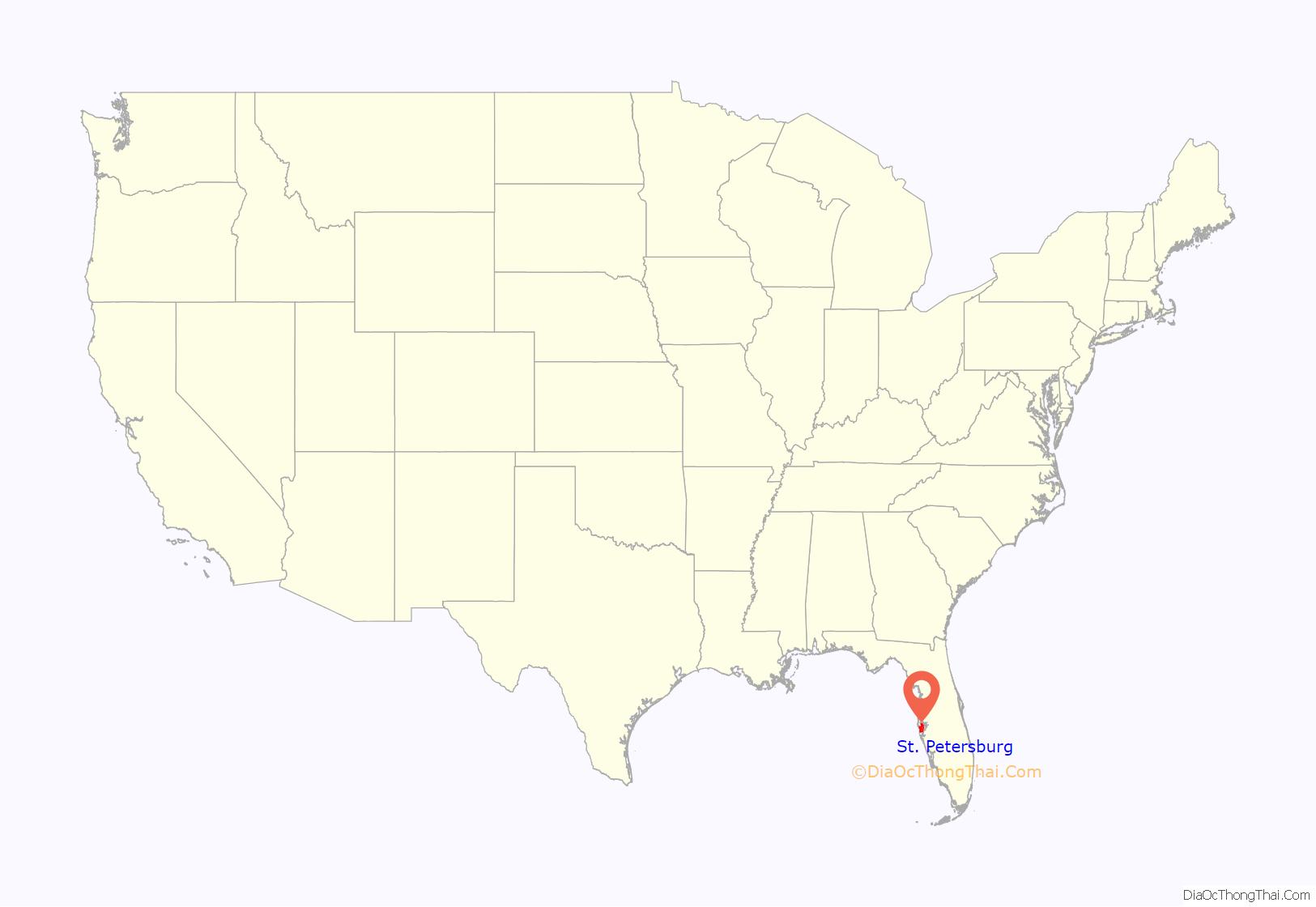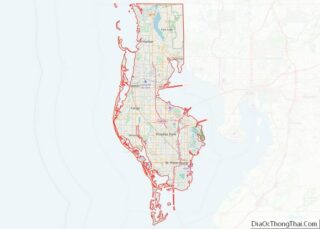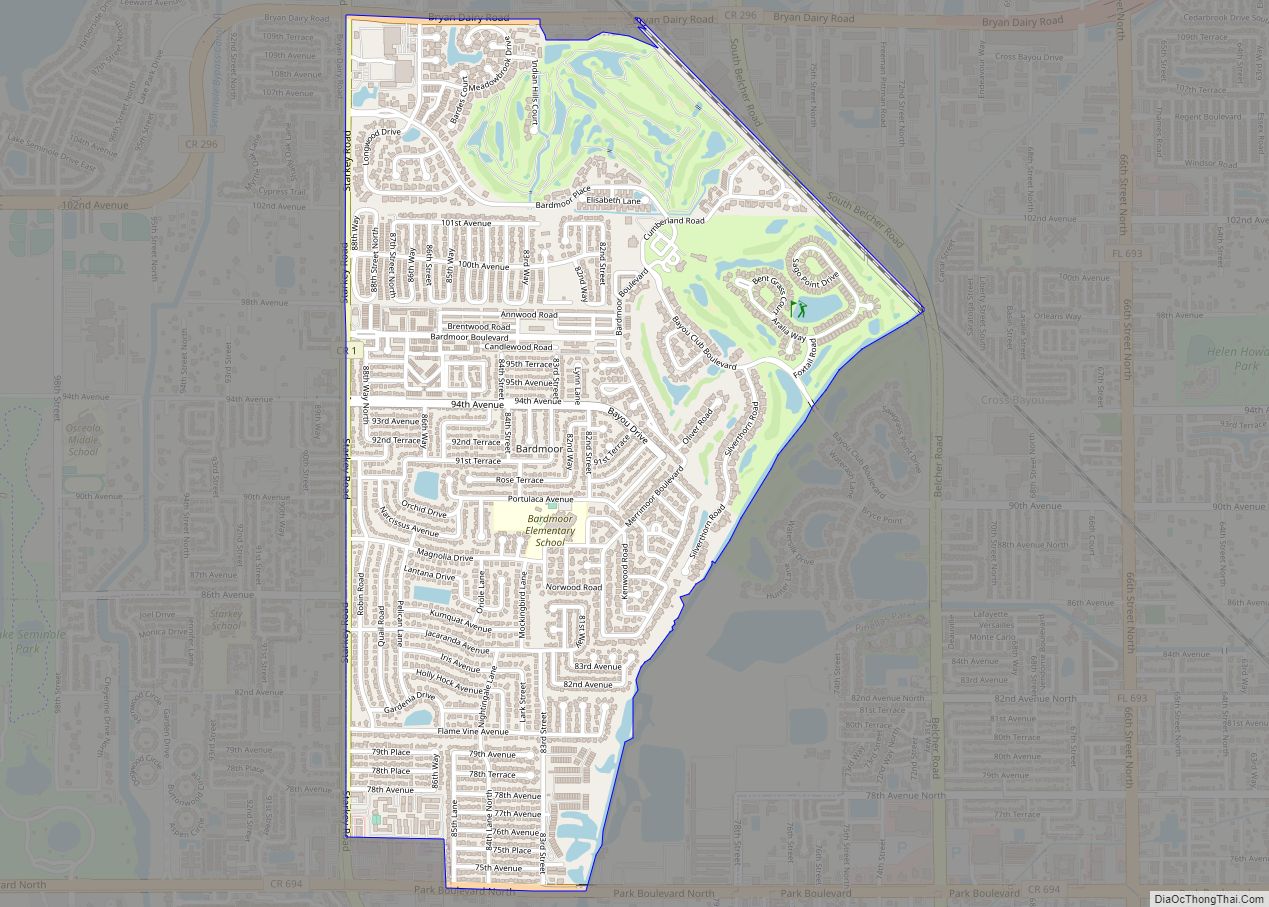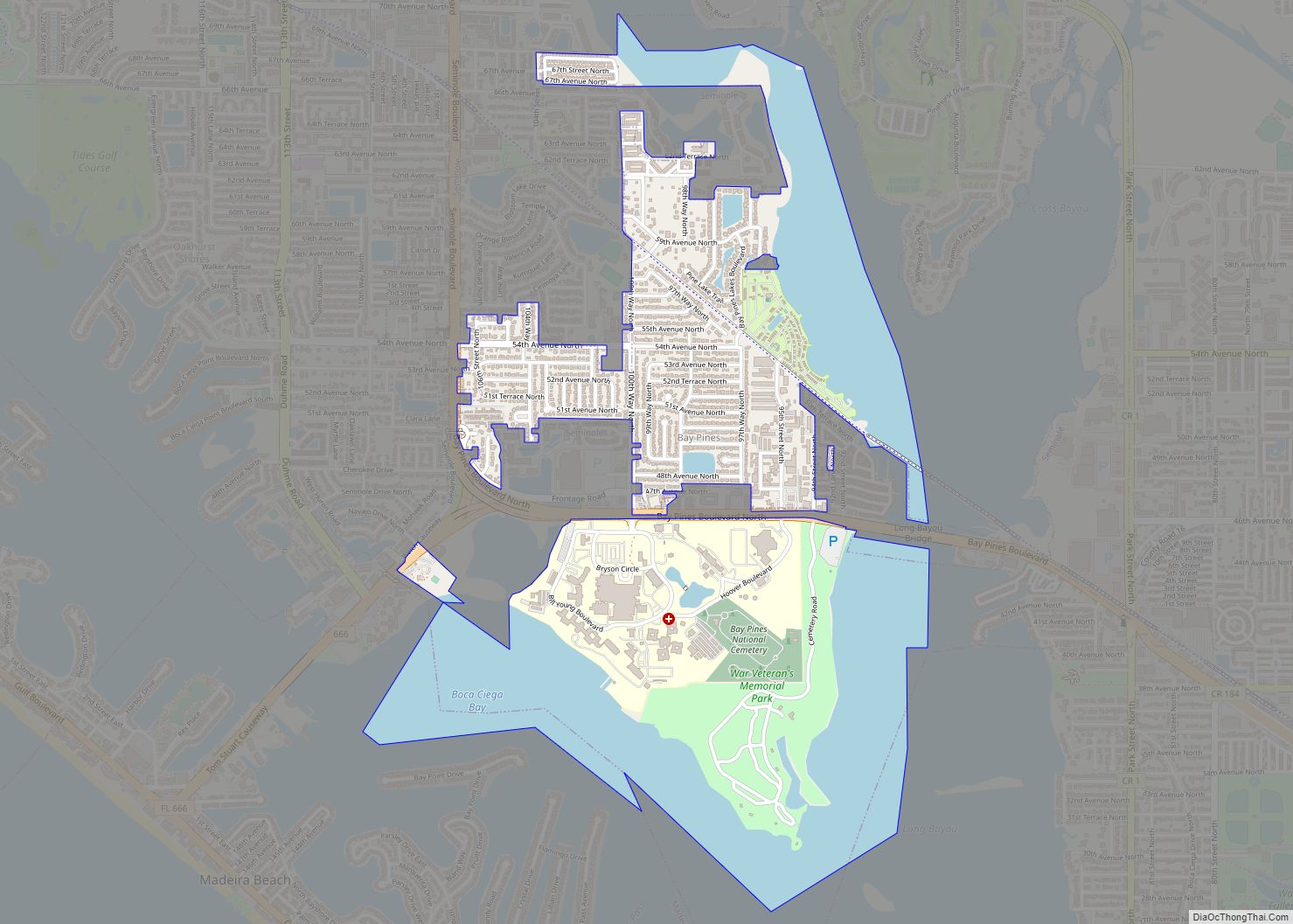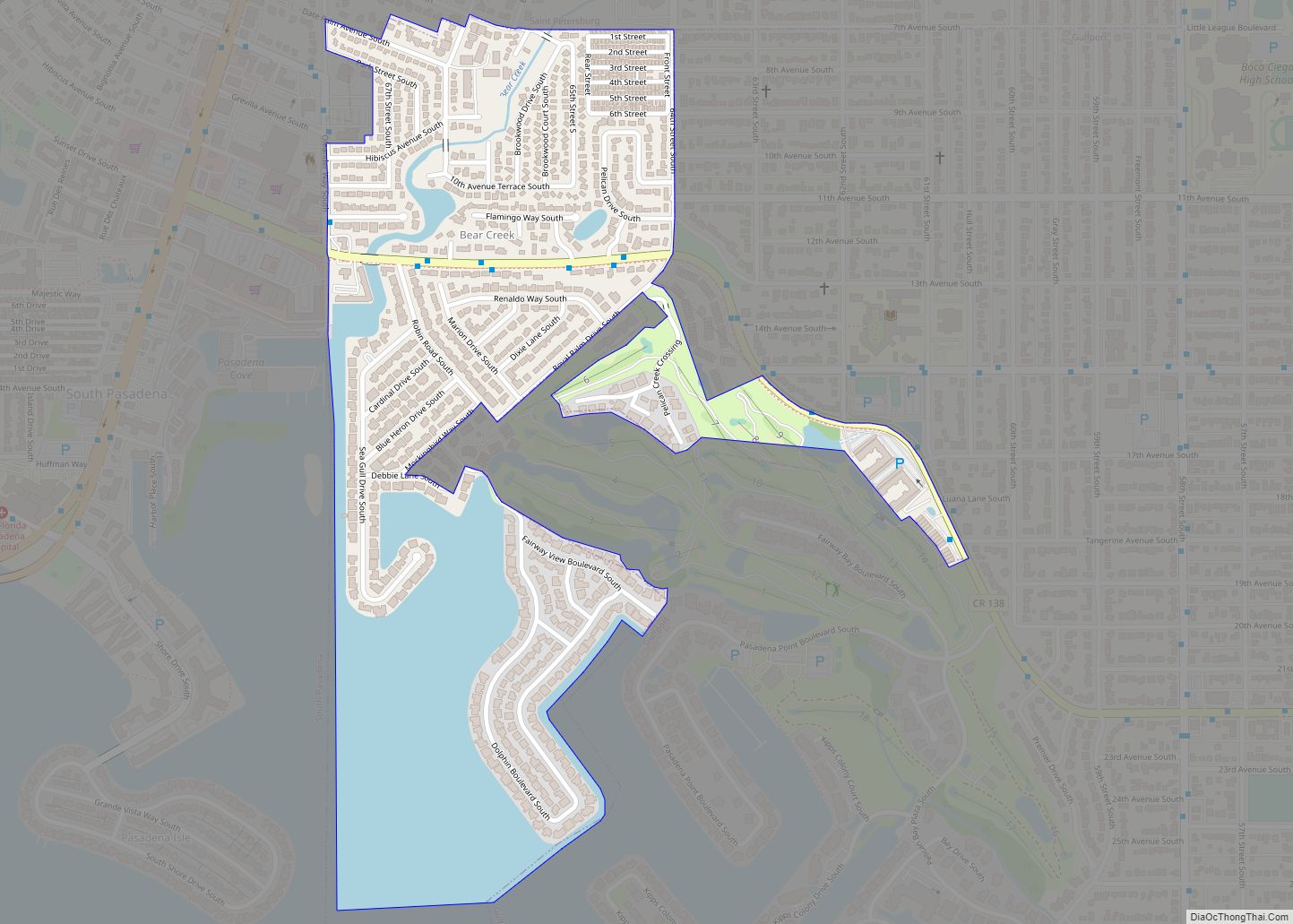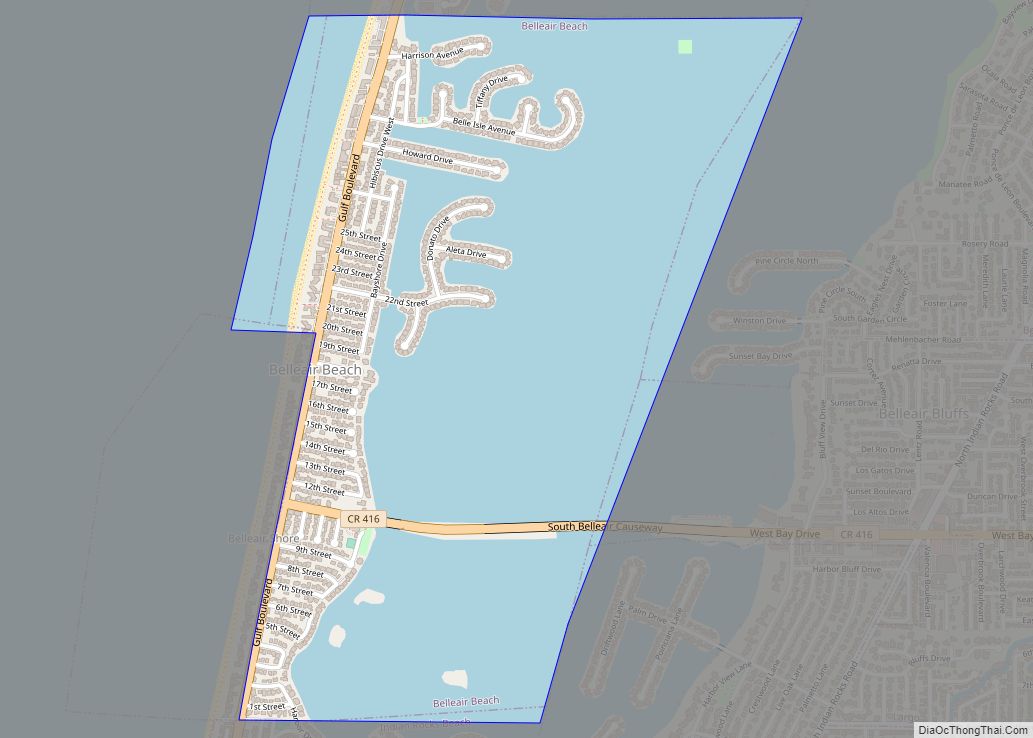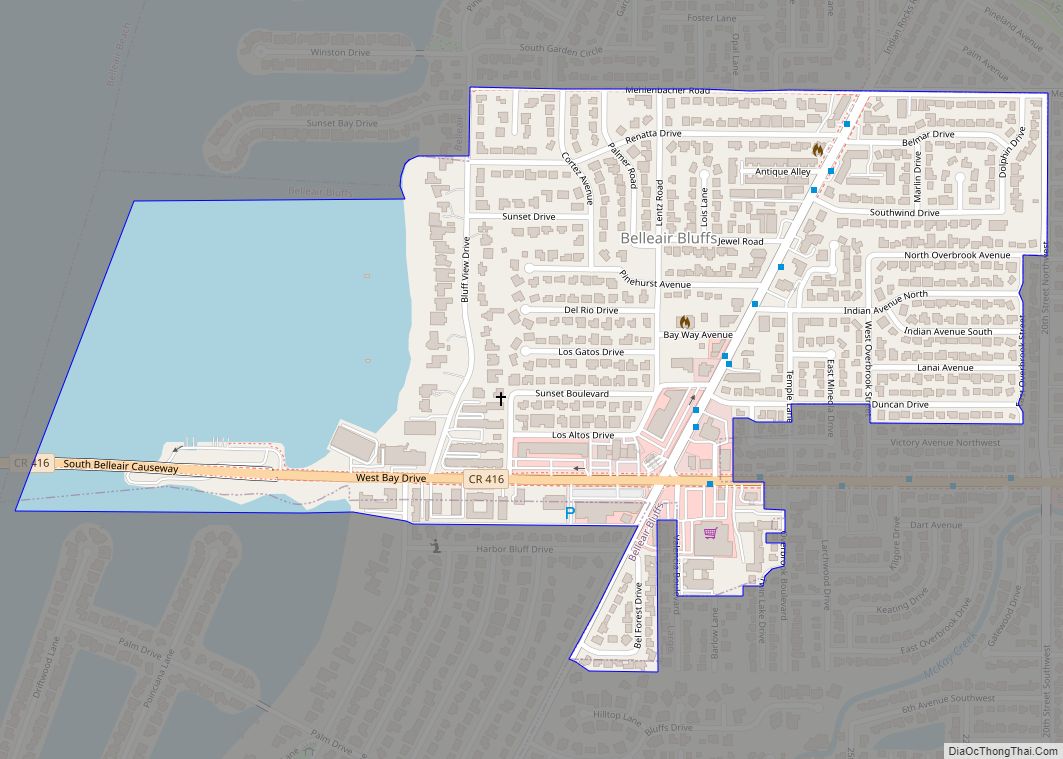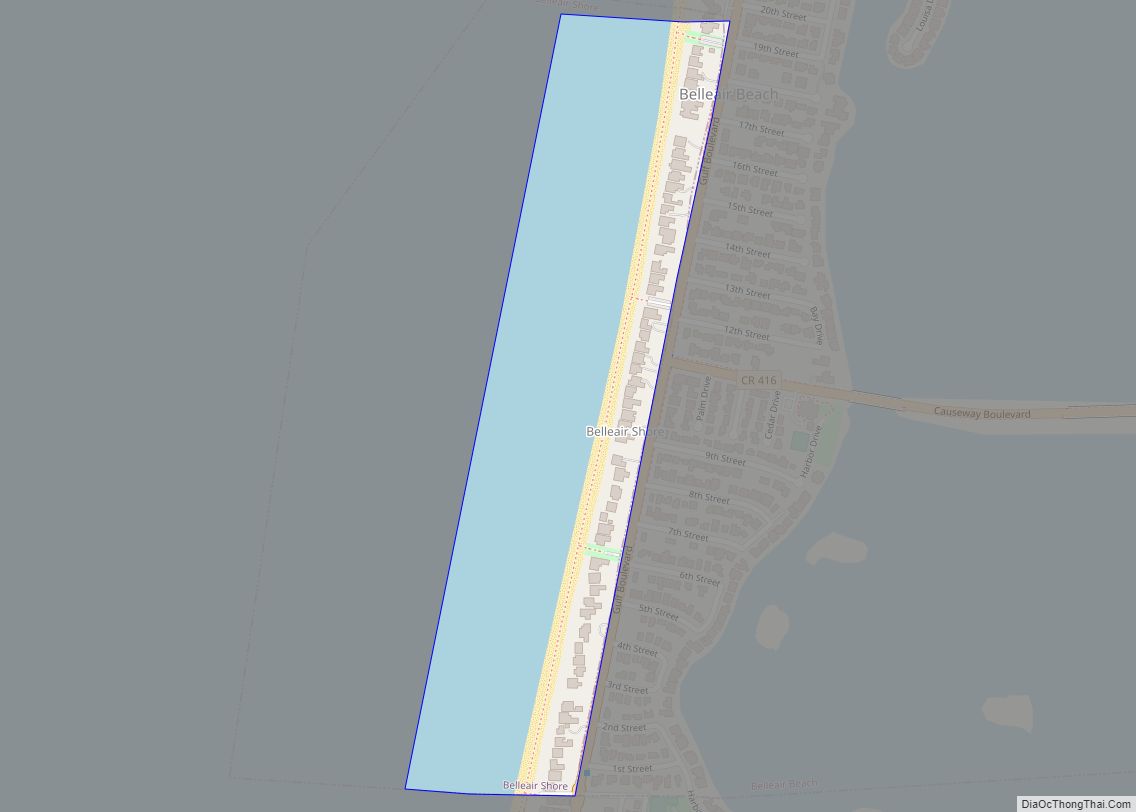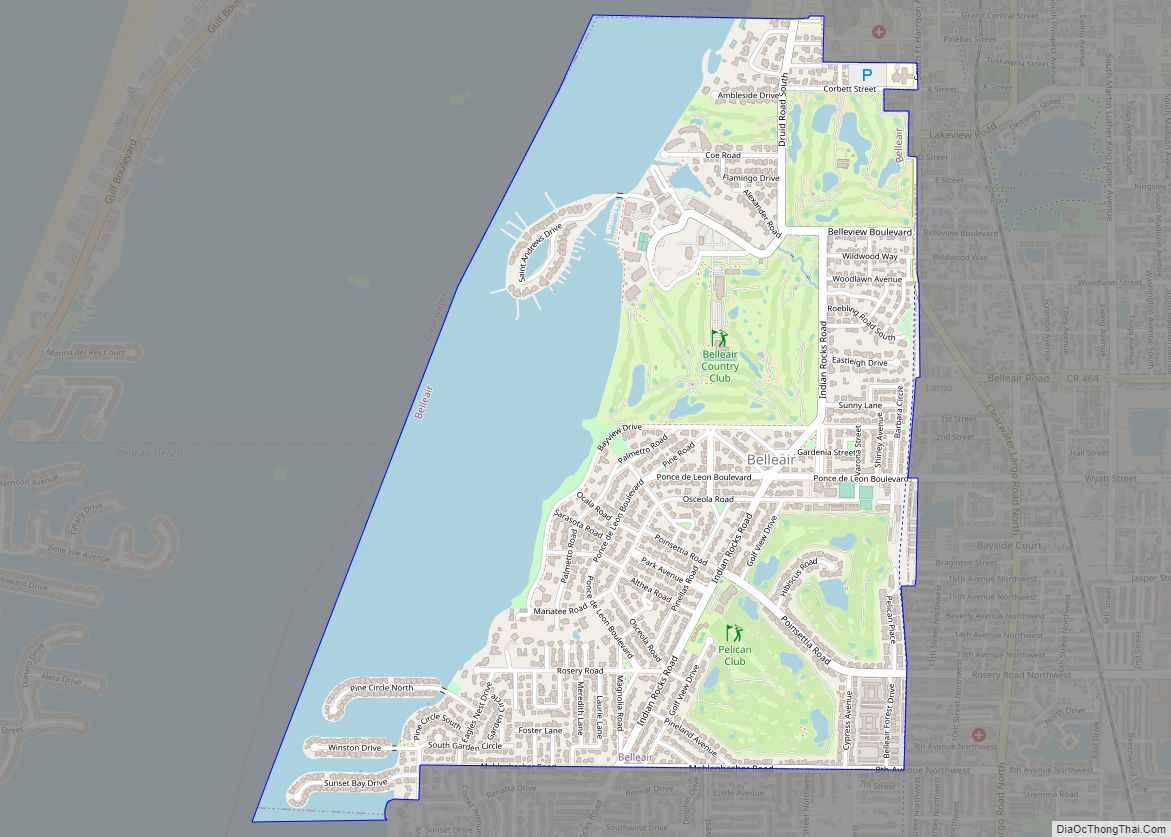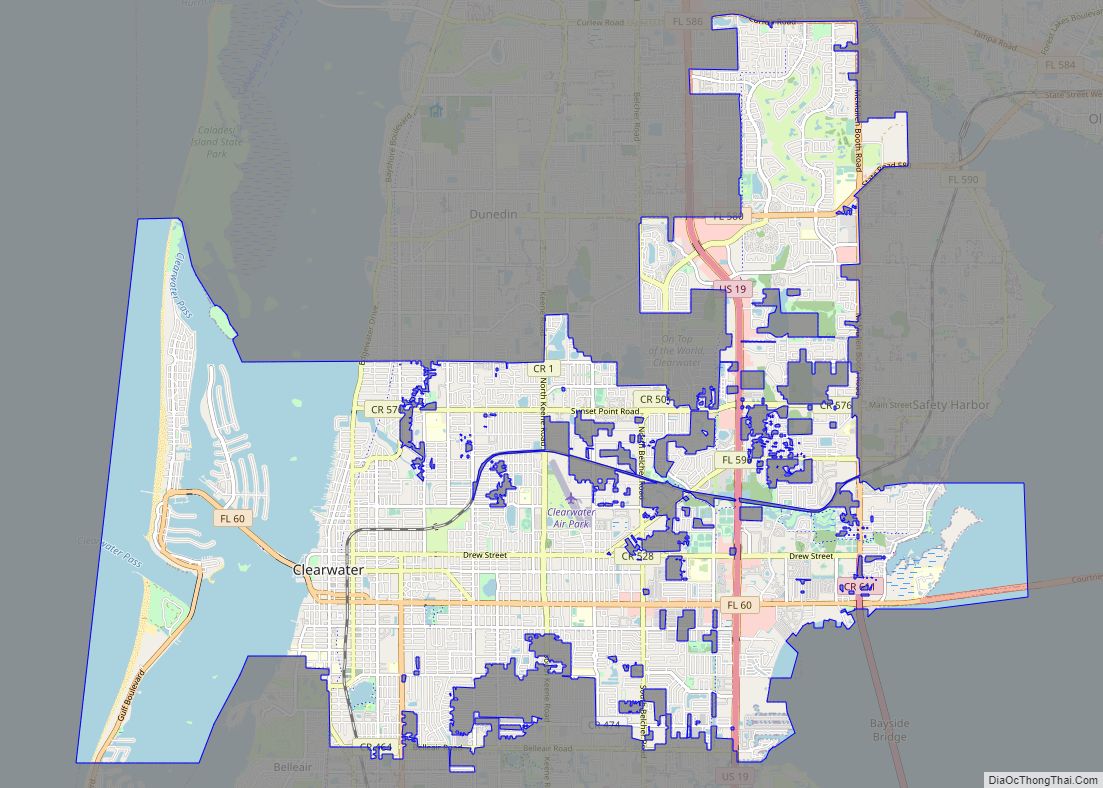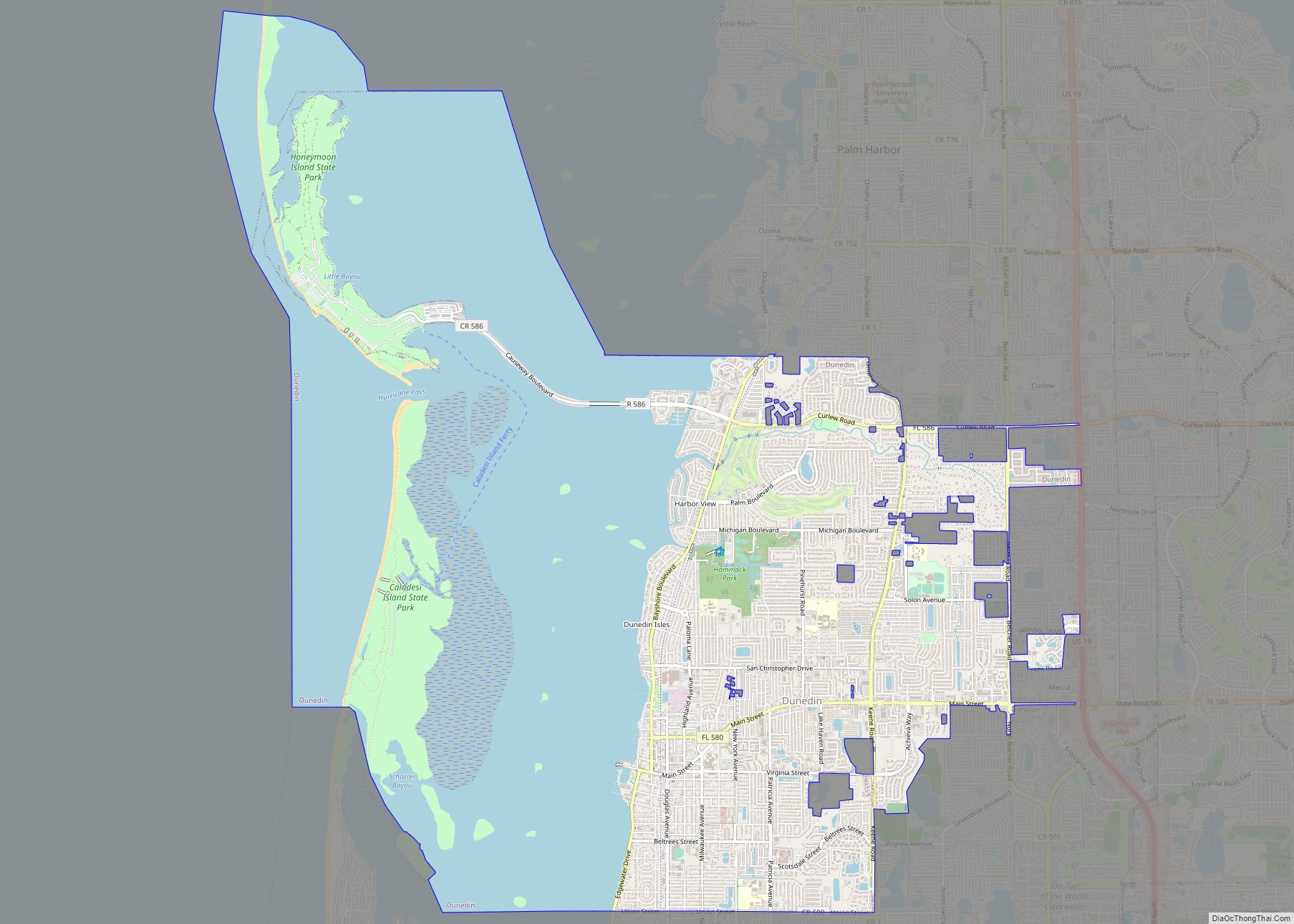St. Petersburg is a city in Pinellas County, Florida, United States. As of the 2020 census, the population was 258,308, making it the fifth-most populous city in Florida and the second-largest city in the Tampa Bay Area, after Tampa. It is the largest city in the state that is not a county seat (the city of Clearwater is the seat of Pinellas County). Along with Clearwater, these cities are part of the Tampa–St. Petersburg–Clearwater Metropolitan Statistical Area, the second-largest in Florida with a population of around 2.8 million. St. Petersburg is on the Pinellas peninsula between Tampa Bay and the Gulf of Mexico, and is connected to mainland Florida to the north.
Locals often refer to the city as St. Pete. Neighboring St. Pete Beach formally shortened its name in 1994 after a vote by its residents. St. Petersburg is governed by a mayor and city council.
With an average of 361 days of sunshine annually, and a Guinness World Record for the most consecutive days of sunshine (768 days between 1967 and 1969), it is nicknamed “The Sunshine City.” Located on the Gulf of Mexico, the average water temperature is typically around 76 °F (24 °C). Due to its good weather, the city has long been a popular retirement destination, although in recent years the population has moved in a much more youthful direction.
| Name: | St. Petersburg city |
|---|---|
| LSAD Code: | 25 |
| LSAD Description: | city (suffix) |
| State: | Florida |
| County: | Pinellas County |
| Founded: | 1888 |
| Incorporated: | February 29, 1892 |
| Elevation: | 44 ft (13.4 m) |
| Land Area: | 61.87 sq mi (160.24 km²) |
| Water Area: | 73.63 sq mi (190.69 km²) |
| Population Density: | 4,175.08/sq mi (1,612.01/km²) |
| Area code: | 727 |
| FIPS code: | 1263000 |
| GNISfeature ID: | 290375 |
| Website: | www.stpete.org |
Online Interactive Map
Click on ![]() to view map in "full screen" mode.
to view map in "full screen" mode.
St. Petersburg location map. Where is St. Petersburg city?
History
Early Spanish exploration
When the Spanish first arrived in the area of Tampa Bay, they encountered people of the Safety Harbor culture. About 20 sites with temple mounds have been found around Tampa Bay, with several in Pinellas County. Best known of the Safety Harbor people was the chiefdom of Tocobaga, which was likely located at the Safety Harbor site in Philippe Park in northern Pinellas County. The Pánfilo de Narváez expedition landed on the shores of Boca Ciega Bay at the Jungle Prada Site on April 14, 1528. It was the first inland exploration of North America. Of 300 men on the expedition only four survived. One of the survivors of the expedition, Álvar Núñez Cabeza de Vaca, wrote the first book describing the peoples, wildlife, flora and fauna of inland North America in his Relacion, published in Spain in 1542.
Nineteenth century
The city was co-founded by John C. Williams, formerly of Detroit, who purchased the land in 1875, and by Peter Demens, who was instrumental in bringing the terminus of the Orange Belt Railway there in 1888. St. Petersburg was incorporated as a town on February 29, 1892, when it had a population of 300 people.
Local lore claims John C. Williams and Peter Demens flipped a coin to see who would have the honor of naming the city. When Demens won the coin toss, the city was named after Saint Petersburg, Russia, where Peter Demens had spent half of his youth, while John C. Williams named the first hotel after his birthplace, Detroit (a hotel built by Demens). The Detroit Hotel still exists downtown on Central Ave, but has been turned into a condominium.
The oldest operating hotels are the Pier Hotel (formally Hotel Cordova), built in 1921, and The Exchange Hotel (formalley The Heritage Hotel), built in 1926.
The first major newspaper to debut in Tampa Bay was the St. Petersburg Times which established in 1884. Philadelphia publisher F. A. Davis turned on St. Petersburg’s first electrical service in 1897. The city’s first major industry was born in 1899 when Henry W. Hibbs (1862–1942), a native of Newport, North Carolina, established his wholesale fish business at the end of the railroad pier, which extended out to the shipping channel. Within a year, Hibbs Fish Company was shipping more than 1,000 pounds (450 kg) of fish each day.
Twentieth century
St. Petersburg was incorporated as a city in June 1903. With this transition, the development of the downtown waterfront had dredging of a deeper shipping channel from 1906 to 1908 which opened St. Petersburg to larger shipping. Further dredging improved the port facilities through the 1910s. By then the city’s population had quadrupled to a population of 4,127 citizens. F. A. Davis was instrumental to bringing the first trolley service in 1904.
In 1914, Al Lang invited the St. Louis Browns to move their spring training into the city, then worked tirelessly to make Grapefruit League training in and around St. Petersburg the destination for baseball teams and their fans by the 1920s. Lang eventually became mayor and ambassador for the city, and helped its permanent population grow tenfold in just a decade.
St. Petersburg’s first library opened on December 1, 1915, which still operates to this day as the Mirror Lake Library.
In 1914 an airplane service across Tampa Bay from St. Petersburg to Tampa and back was initiated, generally considered the first scheduled commercial airline flight. The flight took former mayor Abe Pheil to Tampa. The company name was the St. Petersburg-Tampa Airboat Line, and the pilot was Tony Jannus flying a Benoist XIV flying boat. The Tony Jannus Award is presented annually for outstanding achievement in the airline industry.
The city and its tourism industry burgeoned in the 1920s, with up to a quarter million visitors annually coming from Canada, the North and the Midwest by automobile, yacht, and railroad. The city was the principal Gulf Coast destination for long-distance trains of the Atlantic Coast Line Railroad’s Southland (from Chicago and Cincinnati) and Gulf Coast Limited (from New York, succeeded by the West Coast Champion), and Seaboard Air Line Railroad trains such as the Southern States Special (from New York, succeeded by the Silver Meteor). Travel time from across the bay was cut due to the Gandy Bridge’s opening in 1924, allowing direct access to Tampa and the rest of central Florida.
The city took on a Mediterranean flair, with Old Spanish Trail style architecture promoted by Snell Isle founder Perry Snell, whose new country club island homes adopted many elements of Moorish design. Those same elements were echoed in the city’s new Vinoy, Jungle Country Club, Don Cesar and other fine hotels, as well as in Snell’s new skyscraper office building downtown. The 1926 opening of the Million Dollar Pier marked the peak of the boom, adding an attraction that brought both tourists and townspeople together to enjoy fishing, amusements, trolley access and even a local radio station.
The St. Petersburg flag was created in 1927 and was designed by Mayor C.J. Maurer along with a committee of other public officials. It featured an array of colors symbolic of St. Pete’s culture including the sunshine, water and land. The idea came after officials called for a new logo which later became the design for the flag. The pelican featured in the center became a symbol for the “Feed the Pelican Fund” which has supported the birds during the winter months.
Tourism declined by the late 1920s and early 1930s due to the Great Depression. The city recovered later in the 1930s with the help of the Public Works Administration, including a $10 million investment plan in 1939 which helped build the St. Petersburg City Hall. The second World War brought renewed growth, as the city’s Bayboro Harbor became a training base for the U.S. Coast Guard and the Army Air Force chose the city as their technical service training station. The hotels filled for the first time in years, as up to 100,000 troops came to St. Petersburg. After the war, many of those troops who were stationed in St. Petersburg returned as residents or tourists.
In the 1950s, St. Petersburg experienced another population boom, with the return of retiree resettlement to the city. In 1954 the original Sunshine Skyway Bridge opened its first span to link St. Petersburg with Manatee County, connecting the next year to U.S. Route 19 in the city. With a large influx of car traffic, it was decided to remove the city’s streetcar lines.
The development of major transportation continued into the 1960s with the completion of the Howard Frankland Bridge in 1960, creating another connection between St. Petersburg and Tampa. St. Petersburg also received its first stadium named the Bayfront Center which hosted the first professional hockey league in Tampa Bay. A new municipal marina and the Museum of Fine Arts were also built downtown. St. Petersburg is home to one of the world’s largest reclaimed water systems that was built in the 1970s which flows 37 million gallons of water per day to provide for customers located throughout the city.
From May to August 1968, 211 of the city’s sanitation workers struck for higher wages. The strike began approximately one month after Martin Luther King, Jr.’s assassination in Memphis, Tennessee while supporting that city’s sanitation workers strike.
In 1984, a full-scale flying replica of the Benoist XIV flying boat was constructed by Florida Aviation Historical Society for the 70th anniversary of the flight. This aircraft is now on loan to the St. Petersburg Museum of History in St. Petersburg, Florida.
Contemporary history
Development of the first Major League Baseball team to be located in the Tampa Bay area began in St. Petersburg throughout the 1970s. The city tried to encourage numerous teams through the United States to make St. Petersburg their new home. Designs for a ballpark were first presented in 1983 and construction for a permanent dome stadium began in 1986. The stadium opened in 1990 as the Florida Suncoast Dome, renamed the Thunderdome in 1993. After many attempts to attract tenants to the new stadium, Major League Baseball gave St. Petersburg a franchise in 1995. In 1996, the dome was renamed a third time to Tropicana Field after naming rights were established with Tropicana Dole Beverages. The Tampa Bay Devil Rays was then established in 1998 after the stadium’s renovation and the new team played their first game on March 31, 1998, giving the Tampa Bay area their first professional baseball team.
The city population continued to multiply during the 20th century, booming through the 1970s as a popular retirement destination for Americans from midwestern cities, reaching 238,647 in the 1980 census. Serious urban problems and destruction of historic structures stymied growth in the subsequent decade and a half, but renewed interest in urban living by family aged residents and the expansion of the downtown university and related services has renewed its growth.
Jack Kerouac also spent his final days in the city. His house is preserved as museum.
St. Petersburg Road Map
St. Petersburg city Satellite Map
Geography
Topography
According to the United States Census Bureau, the city has a total area of 137.6 square miles (356.4 km). 61.7 square miles (159.9 km) of it is land, and 75.9 square miles (196.5 km) of it (55.13%) is water. St. Petersburg is bordered by Tampa Bay’s three sections, Old, Middle and Lower Tampa Bay.
Downtown
Downtown St. Petersburg is the Central Business District, containing high rises for office use. The Tampa Bay Times newspaper is headquartered in the downtown area. The Poynter Institute, which owns the paper, is located on 3rd Street South.
The Mahaffey Theater complex, the Morean Arts Center, dozens of other art galleries, The Coliseum, Palladium Theatre, and Jannus Live are among the galleries and cultural venues featured downtown. Several prominent museums are located in the perimeter. Many of them have received notable accolades, including the Chihuly Collection presented by the Morean Arts Center, the Museum of Fine Arts, the Salvador Dalí Museum, the now-closed Florida International Museum, the St. Petersburg Museum of History, Florida Holocaust Museum, and the James Museum of Western and Wildlife Art. The city hosts many outdoor festivals throughout the year.
St. Petersburg’s downtown has been rated among the best in the South, with many waterfront parks and attractions. The area’s gulf beaches are a 10-mile (16 km) drive from downtown, and are connected with downtown by the SunRunner Bus Rapid Transit line.
Jutting a half mile into the bay was the St. Petersburg Pier, a major tourist attraction that offered various activities. “The Lens” design which was chosen by the International Design Competition Jury and accepted by City Council later had its contract terminated by a citywide election during the summer of 2013. Following this, the “Pier Park” was chosen out of the 16 new design teams that submitted work in late 2014 and in 2015 the Pier Park was set for construction in early 2017. The new Pier District opened on July 6, 2020, and contains green space, the Marketplace, playground, splash pad, and several public art installations, including Janet Echelman’s aerial net sculpture, Bending Art.
Downtown also contains the University of South Florida St. Petersburg and a downtown branch of St. Petersburg College. The downtown perimeter includes several parks, most of which are waterfront or lakefront. Straub Park is nearly a half mile long, boasts a waterfront location, and is home of the St. Petersburg Museum of Fine Arts. Because of the number of parks in the downtown area, The Trust for Public Land ranks St. Petersburg 1st in Florida and 15th out of 100 of the largest cities in the U.S. The Vinoy Park Hotel has a bayfront location, a spot on the National Register of Historic Places, and an AAA Four-Diamond rating. It fronts Vinoy Park, which holds music festivals, including the Warped Tour. Nearby is the historic Tramor Cafeteria building, now part of the Tampa Bay Times. The city is connected via the Looper Trolley.
Many dining and nightlife locations can be found downtown on or near Central Avenue extending to 34th Street in the west or Beach Drive along the waterfront. Venues include Jannus Live and the State Theatre. The active nightlife scene is credited to recent demographic and regulatory changes. In 2010, the city council voted to extend bar hours until 3 A.M., identical to cross-bay “rival” Tampa.
Tropicana Field, home of Major League Baseball’s Tampa Bay Rays, is located in the western part of downtown. Until 2008, the team played its spring training games at nearby Progress Energy Park. This setup was unique, making St. Petersburg the first city that played host to its baseball team during spring training as well as the regular season since the 1919 Philadelphia Athletics. At the end of 2007, there was a debate over a new stadium to be built on the downtown waterfront at the current Progress Energy Park site. Tropicana Field would be demolished and replaced with prime residential and retail space. Completion of the stadium was planned for 2012; however, the proposal has been tabled indefinitely while a community-based organization investigates all alternatives for new stadium construction.
St. Petersburg has the third-largest dedicated public waterfront park system in North America, with a waterfront park system that stretches 7 miles (11 km) and is used year-round for public events, festivals and other activities. In the early 20th century, citizens and city leaders engaged in a long and boisterous debate over the future of the young city’s waterfront space, with one side advocating for commercial, port and industrial development and the other side advocating for a long-term commitment to parks and public access to the waterfront. The public access and park contingent won the debate when, on Christmas Eve 1909, the city announced the acquisition of the waterfront land that is encompassed by the waterfront park system.
The city is also becoming one of the largest destinations in Florida for kiteboarding with locations such as Fort De Soto Park, Pass-a-Grille, and Ten-Cent.
The St. Petersburg Shuffleboard Club was established in 1924 and gained attention as the “World’s Largest Shuffleboard Club” with 110 courts and over 5,000 members in the 1950s and 1960s.
Northshore Aquatic Complex is a public pool and small water park located downtown on the St. Petersburg waterfront. Northshore contains a 50-meter pool with diving board, 25 meter training pool with zero depth entry, a play pool, and is home to both Saint Petersburg Aquatics swim club and Saint Petersburg Masters swim club.
Cityscape
Neighborhoods
St. Petersburg is home to more than 100 neighborhoods, with most of the historic districts located near the bay. On the central Eastern edge of the city is Downtown St. Petersburg, which includes the city’s residential and commercial skyscrapers, art galleries, museums, and parks.
The downtown area is home to the central business district and to many start-up companies, corporate branches, banks, law firms, and restaurants. Apart from downtown’s business and cultural offerings, the area also includes a branch of St. Petersburg College and the campus of the University of South Florida-St. Petersburg. The downtown district is home to two professional sports teams, the Tampa Bay Rays, which play in the western part of downtown at Tropicana Field, and the Tampa Bay Rowdies, which play along the downtown waterfront at Al Lang Stadium.
North of downtown lie the Historic Old Northeast and Snell Isle, which both have Mediterranean style historic and waterfront homes, parks, and recreational areas. Old Northeast is home to a shopping district, city landmarks, beaches, and small shops as well as small residential high rises. Snell Isle was founded by C. Perry Snell who bought up the land to develop upscale properties in the 1900s, and helped create some of St. Petersburg’s resorts such as the Vinoy Park Hotel and the St. Petersburg Woman’s Club, both of which are listed on the U.S. National Register of Historic Places. The far north consists of the Gateway area which overlaps part of Pinellas Park, home to major employers such as Home Shopping Network and currently the site of much construction of residential and business buildings and of new toll roads.
The central portion of St. Petersburg includes the Grand Central District and Historic Kenwood. The Grand Central District houses the city’s cafes, art galleries, restaurants, and bars all owing to the Craftsman style architecture. Historic Kenwood is filled with art studios and galleries similarly to the Grand Central District.
South of downtown is Historic Roser Park, which houses historic Mediterranean and Eclectic style housing, parks, and museums. The neighborhood is divided by Booker Creek which flows into Bayboro Harbor.
In far western St. Petersburg, north of the separate city of South Pasadena, Florida, is the neighborhood of Pasadena, which includes the intersection of State Road 693 (Pasadena Avenue) and County Road 150 (Central Avenue).
Climate
St. Petersburg has a humid subtropical climate (Köppen Cfa) with some characteristics of a tropical monsoon climate (Am), with a defined rainy season from June through September. Many portions of St. Petersburg, especially along the bay and in south St. Petersburg, have tropical microclimates due to the maritime influence of the Gulf of Mexico and Tampa Bay. As a result, tropical flora like coconut palms and royal palms can be found throughout the city, and the city is home to the Gizella Kopsick Palm Arboretum, a 2-acre (0.81 ha) park which houses over 500 palms and cycads, including a pair of large Jamaican Tall coconut palms which predate the freeze of 1989. St. Petersburg, like the rest of the Tampa Bay area, is occasionally affected by tropical storms and hurricanes. However, the last time a hurricane directly struck the city was in 1946.
See also
Map of Florida State and its subdivision:- Alachua
- Baker
- Bay
- Bradford
- Brevard
- Broward
- Calhoun
- Charlotte
- Citrus
- Clay
- Collier
- Columbia
- Desoto
- Dixie
- Duval
- Escambia
- Flagler
- Franklin
- Gadsden
- Gilchrist
- Glades
- Gulf
- Hamilton
- Hardee
- Hendry
- Hernando
- Highlands
- Hillsborough
- Holmes
- Indian River
- Jackson
- Jefferson
- Lafayette
- Lake
- Lee
- Leon
- Levy
- Liberty
- Madison
- Manatee
- Marion
- Martin
- Miami-Dade
- Monroe
- Nassau
- Okaloosa
- Okeechobee
- Orange
- Osceola
- Palm Beach
- Pasco
- Pinellas
- Polk
- Putnam
- Saint Johns
- Saint Lucie
- Santa Rosa
- Sarasota
- Seminole
- Sumter
- Suwannee
- Taylor
- Union
- Volusia
- Wakulla
- Walton
- Washington
- Alabama
- Alaska
- Arizona
- Arkansas
- California
- Colorado
- Connecticut
- Delaware
- District of Columbia
- Florida
- Georgia
- Hawaii
- Idaho
- Illinois
- Indiana
- Iowa
- Kansas
- Kentucky
- Louisiana
- Maine
- Maryland
- Massachusetts
- Michigan
- Minnesota
- Mississippi
- Missouri
- Montana
- Nebraska
- Nevada
- New Hampshire
- New Jersey
- New Mexico
- New York
- North Carolina
- North Dakota
- Ohio
- Oklahoma
- Oregon
- Pennsylvania
- Rhode Island
- South Carolina
- South Dakota
- Tennessee
- Texas
- Utah
- Vermont
- Virginia
- Washington
- West Virginia
- Wisconsin
- Wyoming
